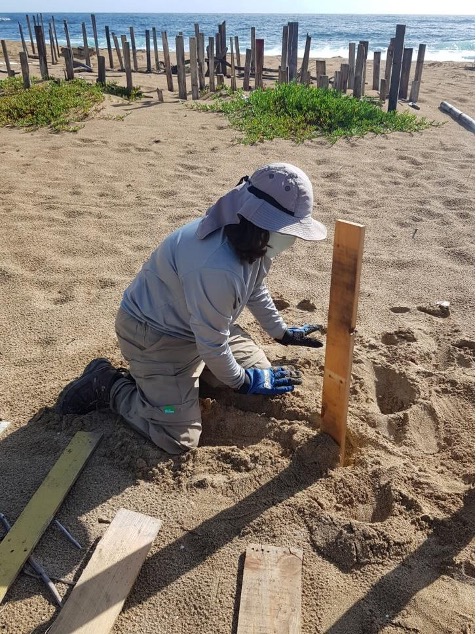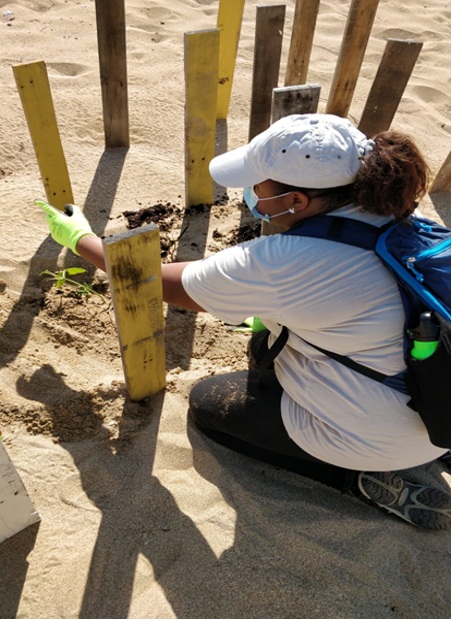Cambios en la Duna a través del tiempo / Changes in the Dunes Over Time
- Climate Science Alliance
- Oct 22, 2021
- 5 min read
Updated: May 6, 2024
Este blog ha sido escrito por María Eugenia del Río, una de las voluntarias líderes del proyecto DUNAS, la cual nos cuenta desde su rol como líder y voluntaria los cambios que ha visto en la duna y en los trabajos. This guest blog has been written by María Eugenia del Río, one of the volunteer leaders of the DUNAS project, who tells us from her perspective as a leader and volunteer about the changes she has seen in the dunes and in the work.

María Eugenia del Río
20 de julio de 2019 – 25 de septiembre de 2021
June 20, 2019 — September 25, 2021
En mayo de 2019 iniciamos los trabajos de creación de dunas en la Playa Boquillas, de la Reserva Natural de la Hacienda La Esperanza. Esta playa había sido impactada por el paso del Huracán María, en septiembre de 2017. Al llegar allí nos encontramos un área de playa totalmente despejada con árboles secos o desprovistos de hojas. In May 2019 we began the work to create dunes at Boquillas beach in the Hacienda La Esperanza Nature Reverse. This beach had been impacted by the passage of hurricane Maria in September 2017. When we got there, we found a completely open beach area with dry trees devoid of leaves.
Iniciamos la actividad observando el perfil de la playa para determinar los lugares adecuados para sembrar las tablas que facilitarán la formación de dunas. Además de colocar las tablas, sembramos verdolagas rosadas (Sesuvium portulacastrum), bejuco puerto (Ipomoea pes-caprae) y otras plantas propias del ambiente costero. Fue una actividad especial, ya que en este proyecto colaboró un grupo diverso, compuesto de voluntarios de todas las edades y diferentes intereses profesionales. We began the activity by observing the profile of the beach to determine the appropriate places to place the boards that will facilitate the formation of dunes. In addition to placing the boards, we sowed sea purslane (Sesuvium portulacastrum), beach morning glory (Ipomoea pes-caprae) and other tropical plants typical of the coastal environment. This was a special activity, as it included a diverse group, made up of volunteers of all ages and different professional interests who collaborated together.
En estas fotografías se puede apreciar el aspecto de la playa, desprovisto totalmente de vegetación y dunas. Sara, su esposo, Rafael, y Rodrigo realizaron una inspección visual, junto con los líderes del proyecto, para determinar el lugar donde se sembrarían las tablas para comenzar el proceso de biomimética. In these photographs you can appreciate the appearance of the beach, totally devoid of vegetation and dunes. Sara, her husband, Rafael, and Rodrigo performed a visual inspection, together with the project leaders, to determine where the boards would be placed to begin the biomimetic process.
La pandemia nos obligó a interrumpir el ritmo de trabajo, de manera que no regresamos a la playa hasta casi un año. Cuando regresamos al área pudimos observar que gran parte de las tablas sembradas estaban cubiertas de arena, más de la mitad de su medida expuesta, aproximadamente dos pies de altura. Las plantas que sembramos apenas fructificaron, de manera que continuamos con nuestros esfuerzos de reforestación. The pandemic forced us to interrupt the rhythm of work, so much so that we did not return to the beach for almost a year. When we returned to the area, we could observe that a large part of the planks were covered with sand, more than half of its exposed measure, approximately two feet high. The plants we had planted previously barely fruited, so we continued our reforestation efforts.

En primavera del 2021 retornamos a la playa, luego de un largo paréntesis ocasionado por la pandemia. Sembramos más especies y también tablas. Desde esta fecha hemos observado que las especies que sembramos han ido propagándose e igualmente las dunas han crecido. Aunque la pandemia ha marcado el ritmo de nuestro proyecto, hemos continuado trabajando el proyecto con las debidas precauciones. In the spring of 2021, we returned to the beach after a long hiatus caused by the pandemic. We sowed more species and planks. Since this date, we have observed that the species we sowed have been spreading and the dunes have grown. Although the pandemic has set the pace for our project, we have continued to work on the project with due precautions.
En estas imágenes Heidi y Marielis colocan tablas y siembran plantas con las debidas medidas de protección y seguridad. In these images Heidi and Marielis place plants with the proper protection and security measures.
Junto al proyecto DUNAS hemos integrado el proyecto de limpieza de playas, y a partir de mayo comenzamos a recolectar plásticos y latas de aluminio para depositarlos en el contenedor de materiales reciclables que facilitó el municipio de Manatí. Este proyecto particularmente ha sido muy exitoso, ya que los visitantes observan nuestro trabajo, lo apoyan y nos expresan que traen sus bolsas de basura para llevarse la basura que producen. Nuestra esperanza es que cada vez recolectemos menos basura y ayudemos a crear una verdadera conciencia ambiental. Alongside the DUNAS project, we have integrated beach cleaning projects and, as of May, we began to collect plastics and aluminum cans to deposit them in the recyclable materials container provided by the municipality of Manati. These efforts have been very successful, since visitors observe our work, support it, and tell us they also bring their garbage bags to take away the garbage they produce. Our hope is that over time, we collect less and less garbage as we help to create environmental awareness.

En esta foto Héctor, Rodrigo, Heidi y María Eugenia con parte del material reciclable que recolectamos en la actividad de Limpieza de Playas, el 30 de mayo del presente año. In this photo Hector, Rodrigo, Heidi, and Maria Eugenia pose with part of the recyclable material that they collected in the beach cleaning activity on May 30 of this year.

En esta imagen podemos identificar a José Martínez junto a una estudiante de biología de la Universidad de Puerto Rico, tomando las medidas de la altura de las dunas utilizando el equipo conocido como nivel. In this image we can see José Martínez with a biology student from the University of Puerto Rico, taking measurements of the height of the dunes using the equipment known as level.
Siempre que regresamos a las dunas podemos observar cambios significativos tanto en la altura de la duna como en la cobertura de plantas. Dedicamos especial atención a tomar las medidas para documentar el crecimiento de las dunas. Realizamos los protocolos cumpliendo con los parámetros de éste y asegurándonos que el equipo que utilizamos se coloque en el mismo lugar del protocolo anterior. De esta manera las medidas son precisas y nos ofrecen un perfil real del progreso del proyecto. Whenever we return to the dunes, we can observe significant changes both in the height of the dune and in the plant cover. We pay special attention to take steps to document the growth of the dunes. We carry out the protocols complying with the methodology we created and making sure that the equipment we use is placed in the same place as the previous protocol. This way, the measurements are precise and offer us a real profile of the project’s progress.

Regresar a la playa y ver el progreso del proyecto nos llena de mucha alegría. A medida que ha ido creciendo la duna, las plantas se han propagado y el área muestra un aspecto totalmente distinto al que encontramos hace dos años atrás cuando comenzamos el proyecto. Returning to the beach and seeing the progress of the project fill us with great joy. As the dunes have grown, the plants have spread, and the area looks totally different from what we found two years ago when we started the project.

This project is made possible through a 2018 Climate Adaptation Fund grant from the Wildlife Conservation Society (WCS) entitled, “Puerto Rico se Levanta: Learning from extreme events to build and sustain a resilient future". Support to establish the Climate Adaptation Fund was provided by a grant to the WCS from the Doris Duke Charitable Foundation.








